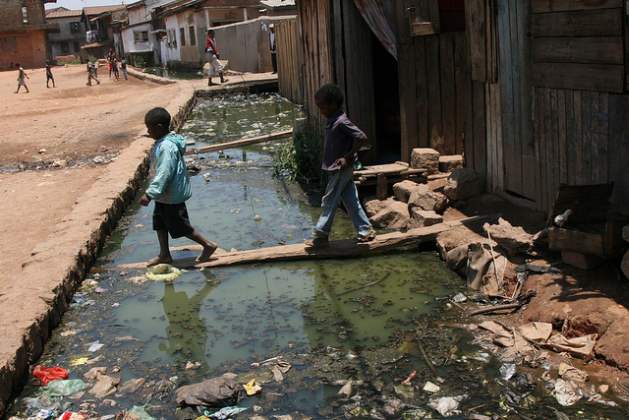PRETORIA, South Africa, Nov 19 (IPS) – World Toilet Day 2023, on 19 November, focusing on ‘Accelerating Change’ – Toilets are a foundation stone of public health and play a critical role in protecting the environment”Celebrated annually on the 19th of November, World Toilet Day aims to inspire concerted efforts in addressing the pressing global sanitation crisis, which currently leaves approximately 3.5 billion people without access to safely managed sanitation.
Even today, a staggering 3.5 billion individuals lack safely managed sanitation, and an appalling 419 million people continue to use ‘open defecation’, a condition that encourages the spread of diseases and claims the lives of 1,000 children under the age of five daily. This sanitation crisis, a hazard to human health and the environment, disproportionately affects women, girls, and other vulnerable groups.
Given the fact that only seven years remain to attain the 2030 target for Sustainable Development Goal 6 – ensuring safe water for all – the global community needs to accelerate its efforts to ensure that the 2030 agenda is realized.
Our current pace, coupled with insufficient funds, escalating demand, deteriorating water quality, and the inadequacies of existing governance frameworks, gravely threatens the realization of this goal.
In alignment with this year’s theme – ‘Accelerating Change’ – it’s imperative that we expedite our global efforts to achieve the UN’s 2030 target. Governments and major institutions must synergistically operate, take accountability for their promises, and timely deliver on them. Actually, every individual, regardless of their contributions’ scale, has a role in accelerating this progress.
Implications of poor sanitation
The implications of poor water and sanitation are widespread and deleterious, gravely affecting individuals who are forced to use unsanitary toilet facilities or consume and utilize contaminated water. Diseases linked to sanitation, like diarrheal diseases, cholera, typhoid fever, hepatitis A, and various parasitic infections, pose significant public health risks.
These illnesses can result in extensive sickness, hospitalizations, and even fatalities, particularly in areas with sparse access to clean water and adequate sanitation facilities. Enhancements of sanitation infrastructure can decrease these disease burdens and elevate public health globally.
Benefits of good sanitation
Absolutely, having good sanitation facilities indeed has numerous benefits. They go beyond the improvement of public health. Proper sanitation infrastructure can reduce healthcare costs as there are fewer cases of sanitation-related diseases. It can also increase productivity as individuals are healthier and can devote more time to work. studies, or other activities.
This results in a better quality of life for individuals and their communities. Furthermore, good sanitation infrastructure contributes to environmental sustainability. It aids in reducing pollution since waste is properly managed and does not end up contaminating water bodies and other natural environments. A safe and clean environment, in turn, helps protect vital natural resources, including clean water sources.
Collaborative efforts
Governments, donors, the private sector, and non-governmental organizations all play significant roles in advancing sanitation infrastructure. They need to cooperate and work cohesively towards delivering water and sanitation services effectively. Furthermore, research institutions can contribute by providing the necessary scientific understanding and technological innovations. This joint endeavour will not just help in achieving the 2030 Agenda for Sustainable Development, specifically Goal 6, but also improve public health and well-being on a global scale.
SADC-GMI’s efforts
SADC-GMI has made commendable efforts by implementing various projects in SADC Member States to ensure everyone has access to water and sanitation as per the United Nations Agenda 2030. These initiatives have positively impacted local communities by ensuring a continuous water supply which ultimately leads to better hygiene. Beyond hygiene, these water supply projects have also brought about improved economic benefits for the communities. Indeed, the projects are transformative, aiding communities in gaining access to dependable water supply for both domestic and economic uses.
These projects, despite the complications posed by climate change, continue to thrive and be sustainable. This resilience greatly benefits communities, offering steady water for various needs. This ties into reaching the sanitation goals defined by the United Nations Agenda 2030.
Yes, with the 2030 deadline of the United Nations Sustainable Development Goals approaching, fast progress is needed to ensure everyone has access to basic sanitation facilities and clean water. Sanitation and drinking water are human rights, and access to these services is crucial for people’s health and the integrity of the environment. To this end, cooperation between different sectors – governments, donors, the private sector, research institutions, and civil society will be critical in facilitating this progression.
Thokozani Dlamini is SADC-GMI Communication and Knowledge Management Specialist
© Inter Press Service (2023) — All Rights ReservedOriginal source: Inter Press Service
Check out our Latest News and Follow us at Facebook
Original Source

